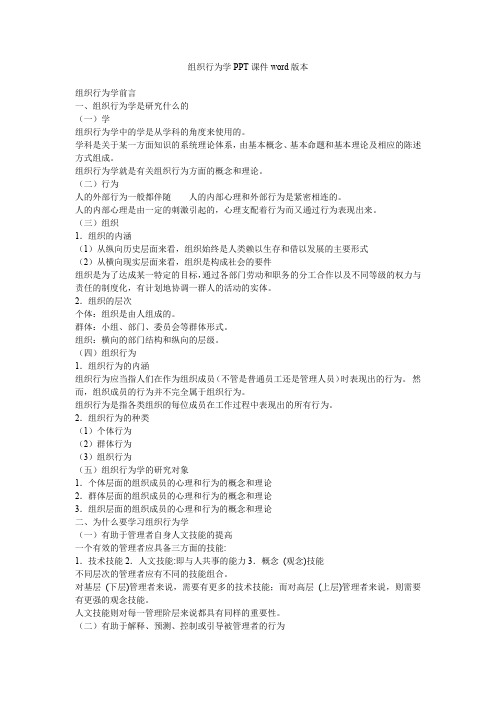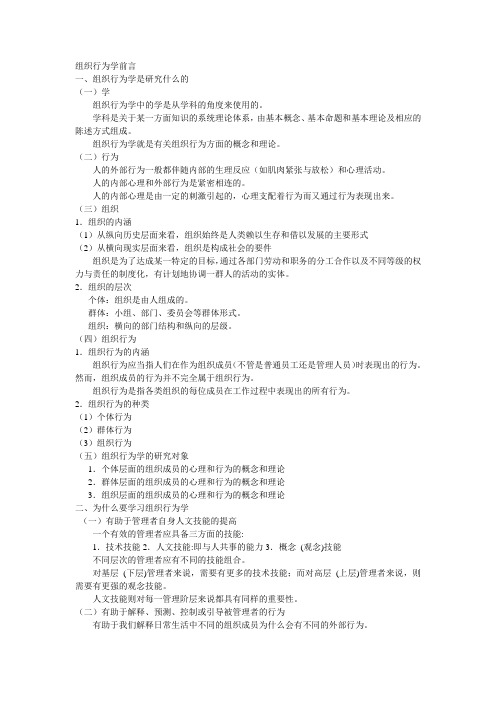公共组织行为学ppt (5)[30页]
组织行为学-PPT课件精品文档

(三)应用性
组织行为学在应用理论性科学原理的 基础上,探索和揭示组织中人的心理与 行为规律性,在掌握这些规律性后还要 进一步研究评价和分析人的心理与行为 的方法,掌握保持积极行为,改变消极 行为的具体技术和措施。
第二节 组织行为学的产生与发展
一、组织行为学的产生
(一)古代社会 那时对组织活动的管理基本上是建立在
一、感觉与知觉
感觉是直接作用于人们感觉器官的客观事 物的个别属性或个别部分在人脑中的反映。
知觉是直接作用于感觉器官的客观事物的 整体属性或各个部分在人脑中的反映。
感觉和知觉的共同点在于,二者都是直接 作用与感官的当前事物在人脑中的反映,所产 生的主观映象都是具体的感性形象。
二、社会知觉
二是凯特的生产效率近来直线上升,作出积极反应。 三是雷莉变得落落寡欢,她认为这么多人被裁减二她
却留了下来,她为此感到内疚,这使她失去了曾经从 工作中得到的乐趣。
第一节 认知差异与管理
没有两个人会以完全同样的方法去看待 问题,此外,人的行为是以将要发生的事实 而不是以现存的事实为基础的。从非常真实 的意义上来说,人们生活在他们自己的认知 世界里。
全体员工共同具有的价值观念,注重企业 中的人际关系,重视做人的工作,把这些 因素称为“组织风土”。
第三节 组织行为学的研究方法
一、研究的基本过程
(一)六步骤法 1.明确问题; 2.探索和研究有关理论和模式; 3.形成假设; 4.选择适当的研究方法; 5.通过观察——测试——实验,进行论证,
1.第一印象效应(首因效应)。 2.晕轮效应。 3.近因效应。 4.定型效应(定势效应)。 5.知觉防御。 6.投射。
1.第一印象效应(首因效应)。
公共组织行为学

地位的思想 (3) 人才流动的思想 (4) 利用外国智力的思想
社会公平理论
在罗伯特•B.登哈特(Robert B .Denhardt) 所著的《公共组织理论》一书中指出“公平 包括平等感和正义感,具体地说,公平的重 点就在于去纠正现存社会价值与政治价值分 配过程中的不平衡。”
公共部门人力资源是指在公共部门中工作的 具有劳动能力的各类人员的总和,是整个社 会人力资源的重要组成部分。公共部门人力 资源包括国家政权组织公职人员、事业单位 人员、公共企业从业人员和民间组织企业人 员 等四个部分。
人力资源管理科学关注三个层次的问题:
微观层次——关注的是组织内部的人力 资源管理效率问题; 中观层次——关注的是某一行业或地区 如何通过利用和开发人力资源谋求优势 的问题; 宏观层次——关注的是在国际竞争中如 何通过开发和利用人力资源管理谋求国 际竞争优势的问题。
人力资源宏观管理
开幕式
“人力”是指人的劳动能力,包括体力、智力、知
识、技能四个部分。人力资源是指一个国家或地区
在一定时期内,能够推动整个国民经济和社会发展
的具有
和
能力的人们的总称。
人力资源的含义
1能推动国民经济和社会发展的、具有智 力劳动和体力劳动能力的总和。
2人力资源是指劳动力资源,即一个国家 和地区有劳动能力的人口总和。
3)、加里•贝克尔《人力资本》,被西方学术界认为是 “经济思想中人力资本投资革命”的起点。他对人力资源 理论的贡献,突出表现在对人力资源的微观经济分析上。
4) 、爱德华•丹尼森《人力资本经济分析方法》也对经济 学中人力资本革命的重大贡献在于对人力资源要素作用进 行了精确的计量分析。
完整版组织行为学讲义ppt课件

1
管理功能
定義:規劃、組織、領導和控制的循環過程。
規劃
組織
管理
控制
領導
2
管理功能與技能
觀念 技能
人際 技能
技術 技能
3
管理者角色
人際角色(Interpersonal Roles) —頭家(Figurehead) —領導(Leadership) —牽線(Liaison)
資訊角色(Information Roles) —督視(Monitor) —傳遞(Disseminator) —發言(Spokesperson)
35
環境決定論 VS.個人決定論
強化理論 認知理論
環境 個人
個人
環境
36
價值觀、態度、及工作滿足
37
價值觀、態度、及工作滿足
A、價值觀
1.價值觀的意義與分類 2.美國的研究發現 3.台灣的研究發現
B、文化差異
C、工作態度
1.態度的意義 2.工作態度的種類 3.認知失調理論
D、工作滿足
1.工作滿足的意義
44
Hofstede文化差異構面(I)
權力距離(power distance): 社會中或組織內 權力不均的程度
不確定的規避(uncertainty avoidance): 社會中 人們對不確定性或不明情境的規避程度
45
Hofstede文化差異構面(II)
個人主義 (individualism)VS 集體主義(collectivism) 傾向自我表現的程度 VS 人們緊密連結的程度
(.IIL .
.E' oAtFt
·l tOK Y U G
.M EX
N
A
-A
组织行为学PPT课件本

组织行为学PPT课件word版本组织行为学前言一、组织行为学是研究什么的(一)学组织行为学中的学是从学科的角度来使用的。
学科是关于某一方面知识的系统理论体系,由基本概念、基本命题和基本理论及相应的陈述方式组成。
组织行为学就是有关组织行为方面的概念和理论。
(二)行为人的外部行为一般都伴随人的内部心理和外部行为是紧密相连的。
人的内部心理是由一定的刺激引起的,心理支配着行为而又通过行为表现出来。
(三)组织1.组织的内涵(1)从纵向历史层面来看,组织始终是人类赖以生存和借以发展的主要形式(2)从横向现实层面来看,组织是构成社会的要件组织是为了达成某一特定的目标,通过各部门劳动和职务的分工合作以及不同等级的权力与责任的制度化,有计划地协调一群人的活动的实体。
2.组织的层次个体:组织是由人组成的。
群体:小组、部门、委员会等群体形式。
组织:横向的部门结构和纵向的层级。
(四)组织行为1.组织行为的内涵组织行为应当指人们在作为组织成员(不管是普通员工还是管理人员)时表现出的行为。
然而,组织成员的行为并不完全属于组织行为。
组织行为是指各类组织的每位成员在工作过程中表现出的所有行为。
2.组织行为的种类(1)个体行为(2)群体行为(3)组织行为(五)组织行为学的研究对象1.个体层面的组织成员的心理和行为的概念和理论2.群体层面的组织成员的心理和行为的概念和理论3.组织层面的组织成员的心理和行为的概念和理论二、为什么要学习组织行为学(一)有助于管理者自身人文技能的提高一个有效的管理者应具备三方面的技能:1.技术技能2.人文技能:即与人共事的能力3.概念(观念)技能不同层次的管理者应有不同的技能组合。
对基层(下层)管理者来说,需要有更多的技术技能;而对高层(上层)管理者来说,则需要有更强的观念技能。
人文技能则对每一管理阶层来说都具有同样的重要性。
(二)有助于解释、预测、控制或引导被管理者的行为有助于我们解释日常生活中不同的组织成员为什么会有不同的外部行为。
公共组织及组织行为学

工资报酬 职工需要
工作表现
能量代谢
需要满足
工作结果
人身价值
人际交往
工作动机示意
社会地位
赫兹伯格的双因素理论
保健因素(外在因素) 激励因素(内在因素)
公司的政策与行政管理 技术监督系统 与上级主管之间的人事关系 与下级之间的人事关系 工作环境或条件 薪金 个人生活 职务、地位 工作的安全感 工作上的成就感 工作中得到认可和赞赏 工作本身的挑战性和兴趣 工作职务上的责任感 工作的发展前途 个人成长、晋升、机会
(2)、复杂文化人的人性设计
人是特定文化的产物 文化制约人的行为状态 文化的差异性造就人与人的不同 文化的变迁决定人是变化着的 社会、文化的复杂性,使得人是复杂的
2、最新管理模式
(1)、软管理思想
管理新变化:
软管理 ——软性资源、柔性方式、文化管理
注重软性资源
40年代中期—50年代末
紧缺经济 数量时代 生产管理 技术硬专家
书名 作者 出版社
公共组织行为学 任浩 同济大学出版社
年份
Байду номын сангаас2006
教学内容设计 1、公共组织行为学的管理模型
(1)、经济人和统御管理模型 (2)、社会人和参与管理模型 (3)、自我实现人与自治管理模式 (4)、复杂文化人与权变软管理模式 (5)、当代中国公共组织管理模型的思考
2、微观组织行为操作设计
市场
时间
政策
财力
人力
物力
文化
关系
信息
2、组织效应
决定:
目的效应 手段服从目的 稀缺:缺一不可
水桶效应
竹竿效应
《公共组织行为学(第三版)》课件第5章 群体行为与公共组织管理

(3)惰性作用。这是群体规范消极的一面。规范作为一种多数人的意见,要求成员行 为趋于一定的水平和范围内,在这种限制下,一些创造性行为会被看作是越轨的行为、 不符合群体要求的行为,这就极易使人们习惯于在规定的范围内思考和活动,影响了 人们积极性和创造性的发挥。
17
2.影响群体凝聚力的因素 (1)群体内部因素。 1)群体规模。2)群体的目标设置。3)奖励方式。4)领导方式。5) 群体成员的相容性。 (2)群体外部因素。 1)群体面临的压力和威胁。2)群体的地位。
18
3.群体凝聚力与工作效率的关系 在论及群体凝聚力与工作效率的关系时,人们常常会直觉 地认为二者呈正相关关系,即群体凝聚力越高,工作效率 越高;反之亦然。但实际上,二者的关系是十分复杂的, 并非如此简单。
6
5.1.3 群体的类型
在现实中,群体存在着多种多样的形式。不同的群体,其活动过程及体现的功能 也不尽相同。依照不同的标准,群体可以分为不同的类型。 1.假设群体和实际群体 按群体是否实际存在划分,可以将群体分为假设群体和实际群体。 2.参照群体和一般群体 按群体的作用和影响划分,可以将群体分为参照群体和一般群体。 3.正式群体和非正式群体 按建立群体的原则和方式划分,可把群体分为正式群体和非正式群体。如何管理 非正式群体呢?可以从以下四个方面入手:(1)正确认识非正式群体。(2)努 力加强正式群体的影响力。(3)合理利用非正式群体为组织目标服务。(4)分 化消极的非正式群体。
组织行为学PPT课件word版本

组织行为学前言一、组织行为学是研究什么的(一)学组织行为学中的学是从学科的角度来使用的。
学科是关于某一方面知识的系统理论体系,由基本概念、基本命题和基本理论及相应的陈述方式组成。
组织行为学就是有关组织行为方面的概念和理论。
(二)行为人的外部行为一般都伴随内部的生理反应(如肌肉紧张与放松)和心理活动。
人的内部心理和外部行为是紧密相连的。
人的内部心理是由一定的刺激引起的,心理支配着行为而又通过行为表现出来。
(三)组织1.组织的内涵(1)从纵向历史层面来看,组织始终是人类赖以生存和借以发展的主要形式(2)从横向现实层面来看,组织是构成社会的要件组织是为了达成某一特定的目标,通过各部门劳动和职务的分工合作以及不同等级的权力与责任的制度化,有计划地协调一群人的活动的实体。
2.组织的层次个体:组织是由人组成的。
群体:小组、部门、委员会等群体形式。
组织:横向的部门结构和纵向的层级。
(四)组织行为1.组织行为的内涵组织行为应当指人们在作为组织成员(不管是普通员工还是管理人员)时表现出的行为。
然而,组织成员的行为并不完全属于组织行为。
组织行为是指各类组织的每位成员在工作过程中表现出的所有行为。
2.组织行为的种类(1)个体行为(2)群体行为(3)组织行为(五)组织行为学的研究对象1.个体层面的组织成员的心理和行为的概念和理论2.群体层面的组织成员的心理和行为的概念和理论3.组织层面的组织成员的心理和行为的概念和理论二、为什么要学习组织行为学(一)有助于管理者自身人文技能的提高一个有效的管理者应具备三方面的技能:1.技术技能2.人文技能:即与人共事的能力3.概念(观念)技能不同层次的管理者应有不同的技能组合。
对基层(下层)管理者来说,需要有更多的技术技能;而对高层(上层)管理者来说,则需要有更强的观念技能。
人文技能则对每一管理阶层来说都具有同样的重要性。
(二)有助于解释、预测、控制或引导被管理者的行为有助于我们解释日常生活中不同的组织成员为什么会有不同的外部行为。
公共组织行为学幻灯片

组织是将各子系统、各要素组合和编 织成为相互依赖、相互影响、相互作用的 有机活动整体之行为。
动词的组织与管理同义
组织
组:安 织:治
配置资源 管理的管
治理资源
管理的理
22
组,织的操作
整分合原则
人岗事原则
能级性原则
责权一致原则 合理授权原则 封闭制衡原则
专业化原则 内在驱动原则
结构化原则 目标认同原则
4
公共组织行为学的价值
提供相关的材料、知识、理论和观察 视角以提高人们认识自己的行为的能力, 增强人们影响他人行为的能力。
培养对公共组织和公共领域的管理和 领导能力,使公共组织能够在充满压力及 变幻莫测的现实世界中做出正确的反应及 行动。
5
2.公共组织行为的活动范畴
个体 范畴
群体
组织
组织
范畴
行为
范畴
公共 范畴
6
组织行为
思维方式
行为模式
公务 人员
公务 团队
公共 组织
公共 领域
7
个体范畴
组 有 工作动机
动机激励
组
织效 目 行 行为态度
态度改变
织 行
标为
活动特征
个性管理
为
8
群体范畴
群体组合
公 群体动力
务 人
沟通行为员 关系协调Fra bibliotek团队建设
部 门 群 体
9
组织范畴
组织体制
部
组织机制
门
组织文化
群
3
公共组织行为学以公共组织对自身的组织 行为及对公共领域的组织行为为研究对象。
组织行为学讲座ppt课件

决策类型量表
陈述内容
1.我更多地依靠实施而不是本能做出决策 2.用逻辑和系统方法作决策我感到更为舒心
完全 同意 同意 一 般 不同 意 完全不 同意
5 5
4 4
3 3
2 2
1 1
3.做决策时我依靠直觉而非其它东西
5
4
4
3
3
2
2
1
1
4.做决策时感到决策的正确性比其合理的理由对我 5 来说更重要
5.即使事实表明选择是对的,我也不会作出在感觉 5 上不对的选择
处理人际冲突的策略(可根据冲突的性质和原因的不 同加以选择)
1、顺其自然法,既避免面对不同的意见,或延续调整的时间 2、粉饰太平法,既强调想法的共同之处,而忽略不同的部分 3、铁令如山法,即运用权势,强迫别人听从命令 4、订定规则法,即以客观的规则作为处理分歧意见的基础 5、和平共存法,即在彼此协议下,维持各存己见的状态 6、讨价还价法,即以协商、交易的方式消除彼此的冲突 7、弃子投降法,即放弃自己的想法,完全以对方的意见为意见 8、全力支持法,即在可容忍的范围内,给予对方最大的支持 9、携手合作法,即将大家的一件整合在一起 10、重组群体法,即将该群体解散,重新组织
人际冲突 人际冲突是指被人们知觉到的一种价值观或目标上的矛盾状态, 并伴有敌意阻碍对手取得成功的行为以及情绪上的敌意。
人际冲突的性质
建设性冲突
双方对实现共同目标的关心 乐于了解对方的观点或意见
破坏性冲突
不愿意听取对方的观点或意见 双方由意见或观点的争论,转变 为人身攻击
大家以争论问题为中心 双方交换情况日益增加
二、个体行为与组织管理
1、社会知觉与管理: 知觉:人对作用于感觉器官的事物的整体属性的反映。 社会知觉包括对他人知觉、角色知觉、人际知觉、自我 知觉。 社会知觉中的偏差效应:第一印象、刻板印象、晕轮效 应、知觉防御、近因效应。 2、个性特征与管理 (1)能力:是指直接影响活动效率使活动顺利完成的个 体特性。包括一般能力和特殊能力。 能力的差异与管理的关系:人尽其才,量才录用。 (2)气质:指人的高级神经活动类型在行为活动中的反 映。气质分为:多血质、胆汁质、粘液质、抑郁质。 气质差异及其管理:气质没有好坏之分、气质影响活动 效率。
组织行为学完整版课件全套ppt教学教程最全整套电子讲义幻灯片

犯隐私群;用物质奖励和行政命令诱使人 员参加试验.
38
本章内容
2.1 价值观与行为 2.2 知觉与行为 2.3 态度与行为 2.4 人格与行为 2.5 能力与行为 2.6 意志与行为 2.7 情感与行为
8
5. 管理中的人事因素
• 角色论----半数活动少于9分钟; 人际----挂名首脑,领导者,联络者 信息传递----监听者, 传播者, 发言人 决策制定----企业家, 混乱驾御者, 资源 分配者, 谈判者
• 成功管理者研究中人的因素
• 组织行为:管理中人的因素
• 成功的管理者----社交联络贡献最大. Fred Luthans.
自尊,权力.经济性(实现目标)
• 组织----对完成特定使命的人的系统性安排。 3要素
• 作业与管理
4
2. 组织和环境
• 存在于组织之外并对组织产生影响作用的 外部事物和现象
• 自然、技术、文化、经济、政治等方面 • 组织和环境进行物质、能量、信息交换 • 组织的利益相关者 • 组织要适应环境的变化;组织对环境的影
• 以研究目标为原则的分类:描述研究、因 果性研究、预测性研究
• 可控性分类的研究方法:案例分析、现场 调查、实验室实验和现场实验
31
一.研究分类
• 设计研究方法时,需要注意:效度,信度, 普遍性.
• 效度,也称有效性,即指标是否测量了它 要测量的研究内容.
• 信度,也称可信性,指测度结果的一致性. • 普遍性行为研究(多数社会科学的研究也
作态度以及周围的人际关系
组织行为学课件

组织行为学课件
智力等级
PPT文档演模板
2020/11/30
组织行为学课件
离差智商
• 到1939年,美国的心理学家魏克斯勒(David Wechsler, 1896~1981)又创编了一种离差智 商,采用统计学中的标准差观念来表示智商的高低, 对智商测试做出重大贡献。测量的范围已经扩大到 2~74岁。有儿童的智力量表,也有成人的智力量 表。
• 自我意识与心境的关系是相互的。正确的自我意识 可以培养积极的心境;反之,可能导致消极的心境。
PPT文档演模板
2020/11/30
组织行为学课件
自我激励
• 是人一切行为的内在动力。 • 自我激励得好可以焕发激情和热
PPT文档演模板
2020/11/30
组织行为学课件
能力的分类: 心理能力 身体能力
• 第二类:灵活性因素 • 广度灵活性──尽可能大的移动身体的能力。 • 动态灵活性──快速重复关节活动的能力。
• 第三类:其它因素 • 躯体协调性──躯体各部位协调一致行动的能力。 • 平衡性──受到外力后保持身体平衡的能力。 • 耐力──长时间启用最大体力的能力。
PPT文档演模板
2020/11/30
组织行为学课件
斯比量表
• 1916年,美国斯坦福大学的心理学家推孟(Terman)教授, 根据比西量表修订出斯比量表,创造出比率智商法。并提出 了智力商数(Intelligence Quotient)的概念替代心理年龄 的概念,简称为智商(IQ)。
• 计算IQ的公式: 智商(IQ)=(智力年龄/生理年龄)×100%
• 同时,测量的内容也从斯比量表的单一智商,改为 语文、作文以及全量表的多项智商。现在,一般使 用的智商一词,实际上指的就是离差智商所代表的 概念。
组织行为学介绍PPT课件

第15页
4、组织行为的分化与综合
进入20世纪80年代,随着社会的进步与科学技术 的发展,组织行为学又分化为微观组织行为学和宏 观组织行为学,微观组织行为学的研究对象,是个 体和群体心理与行为的发展规律,宏观组织行为学 的研究对象,是组织心理和组织行为的发展的发展 规律。
1988年,美国的罗伯特·维卡和富兰克林·斯克伯 兹教授在组织行学分化的基础上,又进一步提出一 个综合的概念——组织科学,他们从微观和宏观、 理论性和应用性两个方面,把组织科学分为四个组 成部分,即微观方面的组织行为(应用性)。
第17页
(二)组织行为学在中国的发展过程
自1978年中国引进行为科学以来,可以分为三个阶段: 1.引进介绍阶段
第一阶段是1978至1984年,称为引进和介绍阶段。 2.组织发展阶段
第二个阶段是1985年1月至11月,可称之为组织发 展阶段。 3.巩固发展阶段
从1986年起,行为科学组织蓬勃发展,学术研究迅 速地、大范围地传播和应用,并且在体制改革和经济 建设中发挥着越来越大的作用。
2、帮助管理者对组织员工进行管理教育 3、指导管理者完善自己的知识结构,提
组织行为学培训PPT课件

• 详细描述:领导者需要了解不同情境的特点和需求,并灵活地调整自己的应对 方式和行为,以实现最佳的领导效果。例如,在组织变革过程中,领导者可以 采用一些变革管理的技巧和方法来引导员工适应变革的需求;而在需要解决冲 突的情境下,领导者则可能需要采取更加客观和中立的方式来化解冲突。
,以达到最佳的领导效果。例如,在紧急情况下,领导者可能需要采取集权的 方式快速做出决策;而在需要团队成员共同参与的情境下,领导者则可能需要 采取民主的方式鼓励员工参与。 • 总结词:领导权变理论认为领导者需要具备灵活应变的能力,以适应不同的情 境和需求。 • 详细描述:领导者需要了解不同情境的特点和需求,并灵活地调整自己的领导 方式和行为,以适应不同情境的需求。例如,在团队建设过程中,领导者可以 采用一些团队建设的技巧和方法来促进团队成员之间的沟通和合作;而在需要 快速决策的情境下,领导者则可能需要采取更加果断和权威的方式来快速做出 决策。
组织文化理论
01
02
03
组织文化理论定义
组织文化理论主要研究组 织的价值观、信仰、习俗 等文化因素对组织成员行 为和组织绩效的影响。
组织文化的塑造
组织文化可以通过领导者 言行、仪式和庆典等方式 进行塑造,形成具有特色 的文化氛围。
组织文化的作用
组织文化可以激发员工的 归属感和自豪感,提高组 织的凝聚力和竞争力。
跨文化组织行为学研究
要点一
文化差异对组织行为的影响
不同国家和地区的文化背景存在显著差异,这些文化差异 对组织行为和领导力有着重要影响。跨文化组织行为学研 究需要深入探索文化差异对组织成员的价值观、行为和团 队协作的影响,以及如何应对文化冲突和提高跨文化沟通 能力。
- 1、下载文档前请自行甄别文档内容的完整性,平台不提供额外的编辑、内容补充、找答案等附加服务。
- 2、"仅部分预览"的文档,不可在线预览部分如存在完整性等问题,可反馈申请退款(可完整预览的文档不适用该条件!)。
- 3、如文档侵犯您的权益,请联系客服反馈,我们会尽快为您处理(人工客服工作时间:9:00-18:30)。
Managing Human Behavior in Public and NonProfit Organizations, Denhardt, 2012, SAGE
□ Captain John R. Paron, former U.S. Navy fighter pilot
Discussion: Do you agree with the statement above? If we properly identify a problem does this mean we don’t have to make a decision because the answer is clear? Is it ALWAYS clear?
Managing Human Behavior in Public and NonProfit Organizations, Denhardt, 2012, SAGE
Are Problems Unique?
□ Most problems are really manifestations of underlying problems that are known but not always obvious.
Decision Making Bottlenecks
□ Global vs Local □ Center vs Business Unit □ Function vs Cross-functional □ Inside vs Outside partners
Managing Human Behavior in Public and NonProfit Organizations, Denhardt, 2012, SAGE
□ Because public managers make their decisions in public view, there is more scrutiny, making decisions more difficult
□ Fishbowl Management
Managing Human Behavior in Public and NonProfit Organizations, Denhardt, 2012, SAGE
• Understand ethical decision making in context of public organizations
• List and define the different models of decision making
• Understand how to make recommendations on who should be involved in decision processes, along with the strengths and weaknesses of each
• List and understand how to use the different decision making techniques available
Managing Human Behavior in Public and NonProfit Organizations, Denhardt, 2012, SAGE
Decision Making Chapter 5
Managing Human Behavior in Public and Non-Profit Organizations
Denhardt
Chapter Objectives
• List the types of decisions made at different levels of organizations
Types of Decisions
• Programmed
– Repetitive and ine – Procedure or decision rule has been
established or may be easily specified
• Non-programmed
– Occur infrequently and are poorly structured – No apparent decision rule – May require engagement in difficult problem
solving
Managing Human Behavior in Public and NonProfit Organizations, Denhardt, 2012, SAGE
Decision Making and Problem Solving
□ If you properly identify the problem and respond as the situation demands, you are not making a decision. You are only making a decision when a paucity of data ensures you have a good chance of being wrong.
Decision Debacles
Organizational Decision Making
• Takes place when a person in authority identifies an important issue and carries out a process to make a choice that produces outcomes with consequences.
